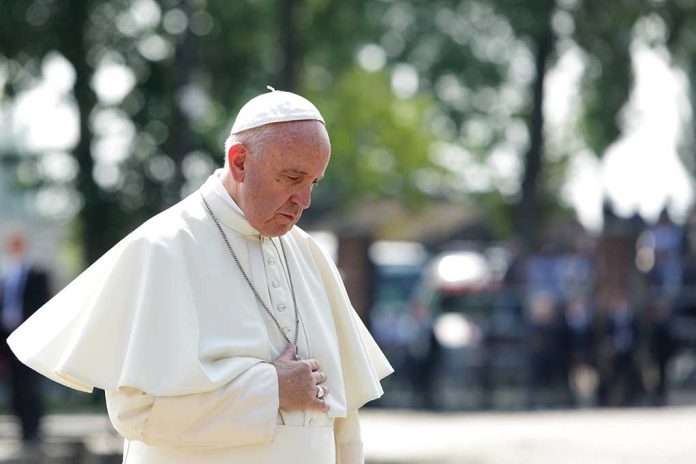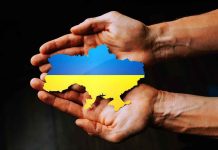
Pope Leo XIV, the first American pontiff in history, meets with Vice President JD Vance to broker peace between Russia and Ukraine as part of a bold new Vatican diplomatic initiative that could reshape the trajectory of a devastating war.
Key Takeaways
- Pope Leo XIV held significant diplomatic meetings with Vice President JD Vance, Secretary of State Marco Rubio, and Ukrainian President Volodymyr Zelenskyy during his inauguration events.
- The Vatican has positioned itself as a potential mediator in Russia-Ukraine peace negotiations, with Pope Leo committing to “make every effort so that peace may prevail.”
- President Trump is planning direct talks with Russian President Putin to end the conflict, while continuing coordination with NATO leaders and Ukraine.
- The high-profile Vatican summit occurred as Russia launched its largest drone attack against Ukraine since the full-scale invasion began.
- Zelenskyy emphasized the need for “real diplomacy” and a “full and unconditional ceasefire” during his meetings with world leaders in Rome.
Historic Vatican Summit Brings Key Players Together
In a historic gathering following his inaugural Mass, Pope Leo XIV met with U.S. Vice President JD Vance and Secretary of State Marco Rubio at the Vatican, signaling a new era in papal diplomacy. The high-profile meetings centered on coordinated international efforts to end the Russia-Ukraine conflict, with the newly installed pontiff showing immediate commitment to leveraging the Vatican’s moral authority toward peace initiatives. As the first American pope in history, Leo XIV’s background as Cardinal Robert Prevost—including his experience as an Augustinian missionary in Peru—brings a unique perspective to global diplomacy at this critical moment.
The Vatican described the discussions as “cordial talks” that reflected “satisfaction at the good bilateral relations” between the Holy See and the United States. Ukrainian President Volodymyr Zelenskyy also participated in the papal inauguration and met separately with Pope Leo XIV, underscoring the potential diplomatic role the Vatican might play. “The authority and voice of the Holy See can play an important role in bringing this war to an end,” said Zelenskyy, Ukrainian President, demonstrating his openness to Vatican involvement in seeking resolution to the conflict.
Trump Administration’s Strategic Peace Push
The Vatican meetings represent a critical component of President Trump’s strategy to end the Russia-Ukraine conflict, which has now dragged on for over three years. Secretary of State Marco Rubio indicated that a direct meeting between President Trump and Russian President Vladimir Putin is being planned, though logistics are still being worked out. The administration’s approach balances urgency with diplomatic reality. “On the one hand, we’re trying to achieve peace and end a very bloody, costly and destructive war. So, there’s some element of patience that is required. On the other hand, we don’t have time to waste,” said Rubio, Secretary of State.
The Vatican summit has already produced tangible results with agreements on prisoner exchanges between Russia and Ukraine. However, the path to full peace remains challenging. Putin recently rejected Zelenskyy’s proposal for direct negotiations in Turkey, highlighting the continued diplomatic impasse that the Trump administration and Vatican are working to overcome. Vice President Vance’s face-to-face meeting with Zelenskyy in Rome—their first since previous contentious interactions—demonstrates the administration’s commitment to rebuilding trust with Ukrainian leadership while pursuing a sustainable peace agreement.
Pope Leo’s Peace Mission and Diplomatic Coalition
Pope Leo XIV has unequivocally committed to peace efforts, declaring he “will make every effort so that this peace may prevail,” signaling a continuation and perhaps intensification of Vatican peace initiatives. The pope’s meetings extended beyond American and Ukrainian officials to include discussions with international leaders participating in the inaugural events, creating a powerful coalition for peace. These leaders included German Chancellor Friedrich Merz, Italian Prime Minister Giorgia Meloni, European Commission President Ursula von der Leyen, and Canadian Prime Minister Mark Carney.
“The authority and voice of the Holy See can play an important role in bringing this war to an end,” said Zelenskyy, President of Ukraine, highlighting the unique moral standing the Vatican holds in international diplomacy.
The Vatican has offered to host formal peace negotiations, building on its longstanding involvement in humanitarian efforts related to the war. While Pope Leo XIV’s American nationality adds a new dimension to Vatican diplomacy, his experience with Latin American politics and international relations during his time as a missionary in Peru has prepared him for navigating complex geopolitical challenges.
Escalating Conflict Underscores Urgency for Peace
The diplomatic summit in Rome took place against a backdrop of escalating military actions, with Russia launching its largest drone attack against Ukraine since the full-scale invasion began. This military escalation targeted multiple Ukrainian regions, though Ukraine’s air force successfully intercepted and electronically jammed many of the drones. The timing of this attack during high-level peace discussions underscores the urgent need for diplomatic intervention and ceasefire agreements, reinforcing the importance of the Vatican-led peace initiative that brings together American, European, and Ukrainian leadership.
Zelenskyy’s diplomatic agenda in Rome included substantive discussions on sanctions against Russia, bilateral trade agreements, defense cooperation, and prisoner exchanges—demonstrating that practical matters continue alongside higher-level peace initiatives. The Trump administration’s approach, combining direct presidential diplomacy with multilateral efforts involving the Vatican and European partners, represents the most comprehensive peace strategy to date. With the Vatican’s moral authority and American diplomatic weight now aligned, the possibility of a negotiated end to Europe’s largest land war since World War II appears more realistic than at any point in recent years.





